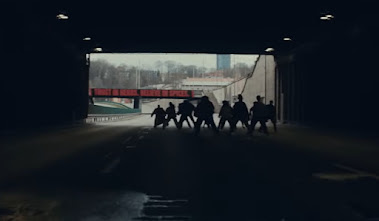I recently visited Northern Spain to walk a small part of the Camino de Santiago de Compostela. I knew
of a few people who had completed the route – backpacking and sleeping in pilgrim’s hostels. Many of the routes are around 460 miles and done the ‘proper’ way they take weeks even months. Some of the early medieval pilgrims spent most of their lifetime on their way.
The pilgrim passport
We were given a pilgrim’s passport which could be stamped at each town or village on the route. This was only a souvenir, and not accredited. We later picked up a scallop shell - the symbol of the Way of St James.
What is the route?There
as many routes as there are starting points, the French Way, the Portuguese
Way, even the English Way. In fact the spiritual journey is said to start as
soon as the pilgrim leaves home with the destination in mind. Unusually - our
final destination was the Atlantic coast around 80 kilometres beyond Santiago
de Compostela.
The
Basque Country
 We flew into Bilbao – the Basque country which
is not on the Camino route, but we had time to eat pintxos which are
delicious snacks on crisp slices of bread.
We flew into Bilbao – the Basque country which
is not on the Camino route, but we had time to eat pintxos which are
delicious snacks on crisp slices of bread.
Euskara
The word pintxos has the
characteristic ‘x’ frequently found in the Basque language Euskara – a language
believed to be the oldest in Europe. It predates all the Spanish invasions, Visigoths,
Moors, Romans and Christians. No one knows where it originated. It is no wonder
that it was banned by the Franco regime from 1939. A private language can
enable people of the same mind to keep secrets.
Our trip took us through Puente de la Reina, Laguardia, Burgos, Astorga and Leon. We found out about the legend of the chickens in the cathedral of Santo Domingo de la Calzada.
 |
| In Santiago we met travellers from all over the world. |
The end of the world
The final stage of our journey was beyond Santiago de Compostela to the Atlantic coast – to Finisterre - named by the Romans and literally meaning ‘the end of the world’.
At the lighthouse at the end of the Finisterre peninsula we spent time looking at the North Atlantic and towards the horizon. The sea was calm and the sky was blue and it was easy to see why even the Romans believed the earth was flat.
Sail too far and you could drop over the edge.
A fish that could talk
Later,
eating Rodaballo (Turbot) at the port of Fisterra I was reminded of the
Basques, their language and their prodigious fishing capability. Mark
Kurlansky’s book ‘Cod: a Biography of the Fish that Changed the World’ starts
with a story which is from Basque folklore.
A medieval fisherman is said to have
hauled up a three-foot long cod, which was common enough at the time. And the
fact that the cod could talk was not especially surprising. But what was
astonishing was that it spoke an unknown language. It spoke Basque.
Kurlansky
points out that in spite of the fact that the cod - a cold water fish - does
not swim off the coast of Northern Spain the cod fishing industry was dominated
by the Basques for centuries. But how and why? As well as being independent and autonomous, the Basques had access to
salt (there was enough sun to dry salt from the sea) and the particular biology of the
cod makes it suitable for salting and drying to preserve it. This meant the
Basque fishermen could cure cod for their own nutrition on vast journeys to
find the shoals of cod fish.
Meanwhile
the Vikings, British and the Bretons were fishing for cod in Icelandic waters. Nobody
knew where the Basques were getting their fish. They certainly were not saying
anything.
Who
discovered North America?
Of
course we no longer ask ‘Who discovered America?’ because we now would
say ‘The people who were living there.’ Christopher Columbus, Amerigo
Vespucci and Vasco da Gama all led to the discovery of the land and the people
who were there already. And as the representatives of imperial powers they
needed to claim the land they had found. But there were signs that people had
been there before.
Columbus landing at the Island of
Guanahaní, West Indies (1846), by John Vanderlyn
In
1497 Giovanni Caboto a Genovese (renamed John Cabot and working for the British
Crown) claimed a ‘New Found Land’ – it had a vast rocky coast line teeming with
cod. Thirty seven years later Jacques Cartier ‘discovered’ the mouth of the St
Lawrence river claiming it for France. As Mark Kurlansky observes
‘He noted the presence of at least 1,000
Basque fishing vessels. But the Basques, wanting to keep a good secret, had
never claimed it for anyone.’
 |
| A statue of John Cabot gazing across Bonavista Bay - Eastern Newfoundland |
The implication is that the Basques had found the coast of what is now Quebec a long way back. Not wishing to alert others to the riches of the sea they saw best to keep it quiet. They had found huge numbers of the Atlantic cod - the largest of the species with the whitest meat.
Perhaps after all it was the Basques who 'discovered' North America.
 |
| Newfoundland Cod Fishing |
























